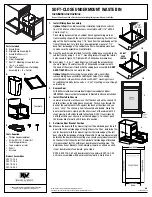
KIROVETS K-744R1, K-744R2, K-744R3, K-744R4 tractors
18
The diagram of the hydraulic system of steering control and mounted implements is given in
Appendix 2.
The
frame
consists of two semi-frames, e.g. the front and rear ones connected by a hinge pivot
device. The semi-frames can rotate in respect of each other around the horizontal and vertical
hinge pivots.
The
cabin
is with a built-in protection framework, all-metal, two-man, hermetic, with heating,
ventilation and air conditioner, with heat absorbing tinted windows. The cabin is fitted with one
entry door on the left side.
Two seats
fitted with safety belts
are installed in the cabin
. The driver’s seat is spring-
supported, adjustable over height, angle of back inclination in the longitudinal direction and
depending upon the driver’s weight.
The
steering column
has five fixed positions, e.g. nominal position at the angle of 25° to the
horizon, three positions at every 5° from the nominal position with pulling inclination and one
position with pushing inclination.
The change of the angle of inclination is performed with the pedal located in the steering column
base being pressed.
The adjustment of the steering wheel over height at the flywheel located in the steering wheel
centre being turned at 2
–3 revolutions.
The
pneumatic system
isthree-circuit ensuring braking of the tractor front and rear axle wheels
as well as trailer wheels.
The system provides simultaneous operation of the brake drives of the front and rear wheels of
the tractor, the energy accumulator drive, the parking brake, air extraction for tyre pumping and
at tractor towing, blowing of air cleaner cassettes and the entire tractor.In addition, the
equipment for trailer brake control is installed on the tractor, which serves both for reducing the
trailer movement speed as a part of the road-train and for its automatic brake in case of break of
the coupler with the hauler.
In the brake pneumatic drive system, there are three mutually independent circuits, e.g. in case
of failure of one circuit, the remaining ones will continue functioning. The circuit independence is
provided by installation of a triple protection valve 3 into the mainline downstream of the
pr
essure regulator 1, which ensures the “cut-off” of the failed circuit from serviceable ones. In
doing so, the serviceable circuits will continue functioning providing tractor braking.












































